At Colorado Harvest Company, one of the state's largest marijuana businesses, pot is grown in coco fiber rather than soil, a substance with no nutrient value. Why? Tim Cullen, the company's CEO, said that allows them to closely monitor all the nutrients going to the plant, all delivered through water.
"We never let water run out of these plants, and if you look in these trays, they're designed to hold water in them," says Cullen. "We don't want any water to run out of the bottoms of the plants because that's just wasted nutrient."
With the legalization of marijuana in various states and forms, conservation groups and others are asking how much legal grow operations affect water consumption. Water managers and researchers in Colorado are working together to answer that question.
Practically every drop of water is accounted for at 's 10,000 square foot grow facility, a practice that Jeff Tejral, manager of conservation for Denver Water, has observed in other grow operations.
"I've been in a lot of commercial and industrial sites for audits and I've never seen a place that's actually written down how much water has been used in an area before," Tejral said. "That was new to me. That was a best practice I'd like to see a lot of people using."
In the early days of Colorado's legal marijuana cultivation, Tejral and other water managers started to pay attention to how much water was being used.
"We also saw the articles coming outŌĆ” : 6 gallons per plant per dayŌĆ” that piqued our interest," he said.
In 2014, California Fish and Wildlife officials started on illegal marijuana operations, which they said were using 6-8 gallons of water per plant per day, stressing drought stricken watersheds. But in Denver, Tejral said he didn't see growers using anywhere near that amount.
"That was way more than what I ever saw," Tejral said. "I would have really noticed that in some of these grow operations with several thousand plants in them."

However, due to the nascent nature of the industry, and the ongoing federal prohibition of marijuana, little official research has been done into exactly how much water cannabis plants use. That limits options for shared industry best practices.
James Zazanis, president of , an agricultural research company in Maryland, is partnering with another marijuana grow facility in Denver to monitor water use. The goal is creating guidelines for the industry. Using soil moisture sensors they monitor in real time how much water the plants are using. While no results are available yet, Zazanis said swhat he's seen at different grow facilities in Denver is encouraging.
"These guys are the leaders in using the newest technology," says Zazanis. "They want to understand how plants work on a scientific level and they're really championing conservation."
At Colorado Harvest Company, Tim Cullen is also eager to see research into conservation techniques.
"When you're talking about the number of plants we're dealing with, this isn't like filling a pitcher up at your sink and watering your house plants," Cullen says, adding that his nutrient bills are close to $10-12,000 a month. "So we're not wasting that water once it has nutrient in it. It really needs to stay in the plant."
And, as the marijuana industry continues to grow and evolve, Denver Water says they'll be looking to Zazanis' findings to help inform them of best practices.
This story comes from 'Connecting the Drops' - a collaboration between Rocky Mountain Community Radio and the Colorado Foundation for Water Education. Find out more at .






